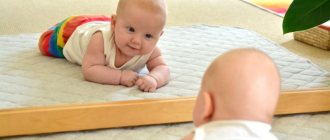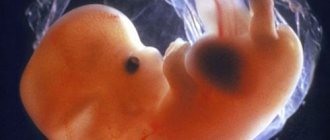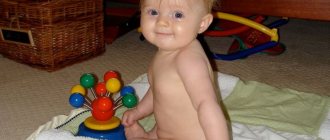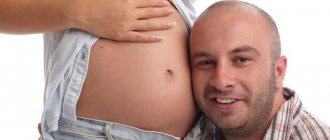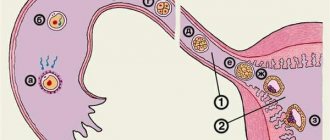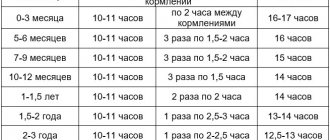What toys are necessary for a newborn?
Toys occupy an important place in the list of children's trousseau. And here, many temptations await future mothers and fathers. What does a baby who is just beginning his acquaintance with the world really need?
It should be noted that toys are not essential items for a newborn baby. In the first weeks of life, he sees them with difficulty, because... his vision is not sufficiently developed: the child cannot yet focus his gaze on objects and sees everything that is further from him or closer than an arm's length as blurry spots. He does not yet know how to follow moving objects. What can we say about the fact that the baby will be able to take the toy in his hand and hold it only a few months later! Therefore, the baby will get acquainted with the first toys only for a few minutes a day and mainly with the participation of an adult who will show him the toys and encourage him to follow their movements.
“Toy number one” for a baby in the first month of life is a rattle. Along with traditional rattles, there are also small electronic musical toys - they are also suitable for the first games of an adult and a baby. Rattles intended for little ones have a diameter of 6-8 cm.
For babies, rattles are also produced, connected into garlands like beads - they are attached to a crib or stroller. For activities with your child, you can also purchase a bright one made of fabric; At first, an adult will show it to the baby, and over time the baby will be able to get to know it on his own. Such a rattle will make the child's tactile sensations more varied. It can have a handle or be worn on the child's arm or leg, like a bracelet.
Pendant toys are also attached to the crib, but using an arc or bracket. Later, when the baby grows up, they can be attached to the playpen.
In the last decade, another toy for little ones has appeared on sale - a mobile phone. This is a kind of carousel that can spin and on which rattles or other small toys are attached. The mobile can be mechanical (in this case it is started with a key) or electric (such toys are battery-powered). When moving, most mobile phones play a soft, pleasant melody.
Manufacturers sometimes indicate the age “from O” on some other toys, including, for example, children’s construction sets. However, they can only be used theoretically for playing with newborns - everything except mobile phones and rattles will be useful to the baby only after a few months.
How to choose your first toys and how to use them? A mobile is not a cheap toy, and the baby will only need it in the first 1-2 months of life. But it is not at all necessary to purchase one: a few ordinary rattles suspended above the child’s crib will be quite enough for his normal development.
If you still decide to buy a mobile, when choosing it, look at what the toys look like from below, because this is the angle from which the child will see them.
Listen carefully to the sound of a rattle or mobile phone: the sound should not be sharp or piercing, otherwise it may frighten the child. It’s good if all the rattles you choose sound different, because the baby needs a variety of auditory impressions.
What time does a child begin to hold a toy in his hand?
For a child to fully develop, he needs toys. They must be selected taking into account the age of the baby and his needs. Despite the fact that children learn to play only after six months, the first rattle appears in babies quite early. First, parents interest the baby in the unusual sound and appearance of the object, and later he himself can touch and look at it. Bright things are a necessary stage in the development of a newborn and children up to one year old.
At what age does a child need a rattle?
You can buy a rattle for a newborn almost immediately after he is discharged from the hospital, and you can attract his attention after three weeks of age. For babies in the first two months of life, the main role of this thing is to attract attention. The whole life of a little person consists of emotions and impressions. He is attracted to everything unusual and new, and this can be any moving object. The baby is especially pleased with bright things that move, as well as all kinds of sounds. This is why small rattles, consisting of several parts, so capture the child’s attention.
If a newborn does not really need toys, then after a month the need for them arises. Rattles are involved in human development, influencing the following:
- Development of vision and concentration. When mom or dad shakes the rattle and moves it from side to side, the baby watches it with interest and surprise. If you show your baby a new toy along with an already familiar one, he will concentrate all his attention on the first one. By sharply hiding it, you can watch how the child looks for the thing that interests him with his eyes.
- Development of auditory perception. Despite their young age, children respond well to the sound of a rattle. If you shake the toy slower or faster, you can notice the child's surprise and joy. An unexpected sound from the other side makes the baby turn his head and turn his attention to its source.
- The appearance of new objects next to already familiar ones allows the baby to develop his memory well, forcing him to closely study the unexpectedly appeared rattle.
Little kids are not able to control their arms or movements, so they express their joy with a smile, humming, and surprised eyes. After two months, the baby begins to wave his arms and legs in response to a new toy, laugh and actively “talk.”
When does a child begin to hold objects?
Thanks to the grasping reflex, a baby can hold a small toy well almost from birth. If you give him a small ring, he will grab it with his hand and hold it. However, this happens unconsciously, just as a child grabs his mother’s finger or clings to clothes. A newborn is unlikely to let go of any thing on his own; his fingers will have to be unclenched. Despite the fact that the baby can hold objects at a fairly early age, he is not able to play with them. It is not a fact that he will even understand and see what is in his hand. To attract attention, the rattle should be kept at a distance of at least 30-50 cm from the baby’s face.
Toys hanging in a crib or stroller can be unexpectedly touched by a child when he waves his hand. Sometimes he is happy about this, and the parents think that the baby is playing; in other situations, an unexpected sound and sudden movement can frighten the baby. To prevent such situations, it is necessary to hang rattles at a distance of 40-50 cm from the child until he reaches two months of age.
Closer to three months, the child begins to consciously hold objects in his hands. A toy placed in the hand is quickly grasped and, as a rule, pulled into the mouth. In this way, the baby gets acquainted with an unknown object. At this age, the baby can already look at the toy; he shakes it not quite consciously, but the sound pleases him.
It is not recommended to give heavy rattles to children under 5-6 months of age, as there is a high probability that the baby will hit himself on the head while playing. A little later, the child will begin to choose favorite or new toys from the proposed options, not paying attention to boring and monochromatic ones. An interesting feature is that if a child’s hand is occupied with an object, and the parents place a new one in another limb, the baby will immediately let go of the first one.
When does a child start picking up toys?
After 4 months, the child learns to pick up objects independently. This happens in several stages:
- The baby grabs objects that are located at eye level. He squeezes the toy with both hands and diligently pulls it closer to him to taste it. Also, babies knock on hanging rattles, shake the grabbed object and enjoy the sound.
- The next step is to lift the toy from the surface of the crib or changing table. This happens after five months, initially the baby clamps the object that interests him between his palms and looks carefully, a little later he will learn to take rattles with one hand.
- After six months, the child can already take the desired item from a lying position on his back, stomach or side. The baby confidently takes the toy with one hand, while at the same time the second can also be used with another object. At this age, a small person is able to independently play with a rattle, shake it well, choose the one he likes from several and push away the rest.
It should be noted that a child’s toy may well be his own hand or foot. A child can look at his limb for a long time, taste it, touch it. After 5 months, the baby is quite capable of taking his socks off his feet and happily being surprised at this. At the same age, children are able to clasp their hands together.
When a child reaches the age at which it becomes possible to independently grab an interesting object, it is worth putting away any things that may be dangerous for him. Sometimes even ordinary and harmless parts, according to adults, can cause injury to a baby. Starting from 5 months, you should be prepared for the fact that the heir will begin to actively study the world around him: he will try to grab cutlery from the table while in the arms of his mother or father; pull the tail of a cat passing by; taste the tube of cream left next to it.
All about rattles for newborns
A rattle is the very first toy in a person’s life. Despite the wide variety, they all have one thing in common - bright color and the appearance of sound when shaking. Such objects differ from each other in color, size, number of parts of which it consists, sound intensity and, of course, price.
There is no point in buying a newborn a lot of expensive rattle toys. It’s not a fact that he will like them; when the child grows up a little, he will begin to choose his favorite things, and the rest will have to be put away. In the first six months of the year, the following set will be enough for a little person:
- two or three simple bright rattles of different sizes;
- one or two hanging toys for the crib or stroller (like several connected parts);
- If you wish, you can add a mobile to the crib, but not all children are interested in it. This soft, rustling toy will delight older children.
Closer to 6 months, you can add to the list a toy that develops various senses, consisting of materials of different textures. It is worth remembering that baby rattles should not be large and heavy, nor should they make sharp sounds that could frighten the child.
Types of rattles for children
When entering a children's goods store, young parents often get lost, and this is understandable; it is quite difficult to make out the presented assortment of toys for newborns. Manufacturers of such products try to present rattles in a wide variety of forms, supplementing them with original functions and details. Their main types, available to almost all parents, are as follows:
- Rattle bracelets. In addition to developing the organs of vision and hearing, such toys teach the child coordination of movements. Trying to reach out and take a closer look at an unusual object, the baby gradually begins to control his body correctly. Over time, the baby realizes that in order to produce a sound it is necessary to shake an arm or leg, and in order to taste it, it is enough to bring the limb to the face. It is recommended to use such rattles no earlier than three months of age and for a short period of time.
- Rattles with and without handles.
The choice of such toys is huge, parents are often lost, wanting to buy the best. It should be taken into account that each rattle corresponds to a certain age. — toys without handles are suitable for children who are already six months old. They can have an uneven texture, with various rings and pits, allowing the child to develop fine motor skills and hold an object; — For kids, there are toys with both one and two handles. The latter may be of particular interest to the baby. Having grabbed one rattle with both hands, he will be surprised by the impossibility of spreading his arms to the sides. Single-handle, split-end toy helps exercise and strengthen your wrist. - Rattle pendant. Used almost from the moment you left the hospital. The toy is hung on the baby's crib or stroller; it usually consists of several fastened parts. The presence of this item allows you to develop your baby’s visual skills. After three months of age, the rattle can be hung closer to the baby so that he can reach it, touching it when flapping his arms.
- Ring rattle. This is an ideal option for little ones. Starting from the age of one month, such an object can be conveniently placed in the handle. As a rule, such a toy is made with a special ring surface - it is uneven, ribbed or with pimples, which allows the hand not to slip off and develops fine motor skills.
- Teether rattle. Designed not only for the child's play and development, but also to alleviate his condition during teething. It is usually made of plastic with rubberized parts that the baby can chew without harming the tender gums. The strumming and bright colors distract the child from pain, and the ability to scratch the gums speeds up the appearance of teeth.
- Soft, rustling toys are also considered rattles. A very useful type for children over six months of age. They are made of soft fabric filled with rustling material. Individual parts may squeak when pressed; often a ball is sewn inside, which makes a sound when shaking. Additionally, such rattles may have various irregularities; for example, several types of fabric are used in their manufacture. This allows the child to develop fine motor skills while playing.
It should be remembered that an important criterion for choosing a toy is its quality. You should not buy even the brightest and most multifunctional rattle if it has an unpleasant odor, paint smudges, or is from a dubious manufacturer.
The presence of small parts is also of great importance. If they are present, before giving a new thing to the child, you should forcefully try to tear them off. You should not think that the baby is weak and cannot make out the object. If desired, he will tear off everything that comes out and pull it into his mouth. It is recommended to purchase toys from well-known manufacturers, and if you do not want to overpay for a brand, it is better to choose a domestic manufacturer with a good reputation.
Author: Chuprova Tatyana
Let's make rattles together
comments powered by HyperComments
KrohaPuz.ru
Rattles for babies from 0 to 4 months
A rattle is the most important, most important toy for a child under one year old. It can be any object that makes noise when shaken. It is no coincidence that the first baby rattles in Rus' were bells from horse harnesses. Rattles develop vision, hearing, attention and precision of movements.
Rattles come in different types, and you can choose them based on the age of the baby.
Which rattles are suitable for babies under 5 months?
- Pendant toys or mobiles hanging above the crib attract the baby’s attention, teach him to focus his gaze, follow movement, and develop his eyesight. A little later, the figures from the “carousel” or from the “pendant” can be used separately, like ordinary rattles, since they themselves often “know how” to squeak and rattle.
- The rattles on the handle are figurative and geometric figures. It is important that the toy is bright enough to attract attention. When purchasing such a rattle, you should check whether it is too heavy.
- The rattle on the ring is small and light, perfect for babies in the first two months of life. The toy is usually attached to the top of the ring. It is convenient for children to hold it in their hand and, involuntarily waving their arms, feel something in their palm. Colored moving balls are sometimes placed in the pen ring, which can be observed through transparent plastic.
- Bracelets and socks with rattles attract the baby's attention to parts of his own body and help him begin to correlate his movements with the sound coming through.
- Rattle clubs - in some models, balls or figures are located on both sides of the holder. They teach how to hold objects and look at 2 figures at the same time.
- Latex rattles may smell slightly of vanilla or strawberry, while wooden rattles may smell like juniper or pine. They develop the sense of smell, but may not be suitable for children prone to allergies.
- Soft rattles made from different fabrics (terry, ribbed, silky) stimulate sensitivity. For such toys, the holder can be hard or soft, filled with different grains.
At what months does a baby begin to hold various toys and other objects in his hands?
Things surrounding a baby influence its development, help develop motor skills, attention, and concentration. An important stage is the time when the child begins to hold objects in his hands.
Features of development
A newborn is not interested in toys, but in the 3rd week of life he may become interested in bright objects and follow the rattle with his eyes. The child does not yet control movements, but the grasping reflex is well developed. The baby will squeeze the thing placed in his hand and begin to hold it, but will not understand what happened. This is an unconscious movement; the baby also grabs mother’s finger and clothes. He will not let go of the object on his own; he will have to unclench his fingers.
At what months will your baby start holding a toy? He comes to grasping an object in several stages:
- After 8-10 weeks, he begins to hold inserted objects in his hands, examines them, and often puts them in his mouth;
- Having reached 4 months, he consciously grabs objects that fall into his field of vision, attracts them, tries to shake them and rejoices at the sounds he receives;
- After 5 months, the child tries to take objects from the crib, changing table, holds them with both hands, and gradually learns to cope with one;
- A six-month-old child is able to grab things from a lying position and can simultaneously hold different objects in both hands. Until this moment, children do not have enough concentration to fix a pair of rattles. A child holding an item in his palm unclenches it when he receives the toy in another hand.
Children accidentally touch the rattles hanging in the crib. They may be happy, and adults think it's a game. In fact, emotions can also be negative. To avoid scares, you need to hang toys at least 40-50 cm above the crib until the child is 2 months old.
Learn to hold an object
All classes are conducted in a playful way, with conversation and in a good mood. Any skill takes time and requires diligence and repeated repetitions from the baby. At the first attempts, it is difficult for him to hold the object; he should not be angry with the child, compare, even mentally with familiar children, or get upset. You definitely need to work with your baby, this will significantly speed up the acquisition of new skills and have a positive effect on overall development.
Important!
Doctors are dumbfounded! EXCESS weight after childbirth goes away forever! An effective and inexpensive means for safe weight loss...Read more >>
Grip handles
A sure sign that the child is beginning to explore the world more actively is the connection of the arms above the chest. Usually this movement is accompanied by reaching for an object. To teach grip, you need to connect the baby’s hands: this is how he feels the squeeze of his fingers. The exercise is convenient to perform when the baby is in your arms. While feeding, you can wrap your arms around the bottle.
Putting in hand
You need to interest the child, move the toy in front of him at a distance of 20-30 cm from the chest, and rattle it. Having noticed a thing, the child follows it with his eyes. Then the mother places the rattle in the baby's hands.
It should be placed across the palm, between the thumb and the other fingers - when squeezed it will be more convenient to hold. First, the mother needs to help the child and connect her fingers, grasping the toy.
At first, the baby can grab and quickly release an object, then he begins to fixate it for a few seconds, gradually increasing the time
When the child holds the toy tightly, you need to diversify the exercise, trying to “take away” it: lightly pull it towards you. This way he will feel the tension in his muscles. Gradually, the baby himself reaches for the rattles. Actions must be accompanied by speech, observing interrogative and exclamatory intonation.
A good developmental device would be a rug made from scraps of different textures, with tightly sewn buttons, large beads, and similar things.
Grasping objects
To develop a grasping movement, you need to hang a bright object next to your left or right handle. There is no need to rush and place the toy in the baby’s palm. He must show independence, develop movements, and learn their mechanism. You should not rush your child; you need to follow the algorithm of actions:
- Touch the back of his hand, so he opens his palm;
- To get interested in a thing, to ring;
- Wait for the child to take the offered item;
- If the baby does not show interest, you need to change the rattle and repeat the steps.
Accompany the process with a smile and conversation. Gradually, you need to help the child shake the rattle or squeeze the squeaky toy. He will remember the movement and try to repeat it on his own.
Then you need to bring his free hand to your occupied one and let him touch the object. This promotes the formation of shifting from one handle to another. If you place several toys next to your baby, he will reach for the one he likes.
Important points
When developing your child’s ability to hold objects, you need to consider several recommendations:
- For the first lessons, select toys with a long handle, about 15 cm, then he will be able to pick up small objects. The color should be bright, green, red, orange are suitable. Until six months, do not place heavy objects in your hands, as the baby may hit himself on the head;
- Use toys of different colors, shapes, choose rattles with unusual filling, as well as musical ones. You need to allow your baby to touch objects with different textures. New tactile sensations develop fine motor skills and gradually form preferences;
- You can’t leave your baby alone with a toy, it’s dangerous;
- It is better to choose a time when all needs are satisfied. In a good mood, the baby will be more willing to accept and hold the rattle;
- All exercises must be performed alternately for both handles. Otherwise, the skill of being left-handed or right-handed is formed. The child takes the item being offered with his near hand: this is more convenient and faster. If this moment is missed, the movement becomes a habit after regular repetitions. Subsequently, the baby, simply by virtue of skill, grabs an object with a certain hand from any side;
- It is imperative to praise the child if he takes the toy. This is psychologically important, it allows the child to enjoy success and is a good incentive for further efforts;
- Keep toys clean. Babies taste everything, especially when teething. It is impossible and useless to scold them, but it is necessary to ensure safety;
- Study regularly with your child or ask someone from your family to teach him. Children lose interest when a toy falls out of their hand. If the adult gives the item again, the child continues the activity with pleasure.
The development of babies is individual, some take and examine objects with interest before 12 weeks, more often the skill is formed later. If even at four months the baby does not hold the toy well, you should not panic and consider this a deviation. Much depends on his individual characteristics, the time devoted by his family to games and learning, and breastfeeding plays a positive role.
Suspicions must be reported to the doctor during the examination. If everything is in order with the baby’s reactions, vision and nervous system, you just need to wait, gradually he will learn to reach out and grab the rattle. Sometimes children refuse to pick up things they don't like; you need to try rattles of different colors and shapes.
How to lose weight after childbirth?
Many women after childbirth face the problem of excess weight. For some, it appears during pregnancy, for others, after childbirth.
- And now you can no longer afford to wear open swimsuits and short shorts...
- You begin to forget those moments when men complimented your flawless figure...
- Every time you approach the mirror, it seems to you that the old days will never return...
But there is an effective remedy for excess weight! Follow the link and find out how Anna lost 24 kg in 2 months.
How to lose weight after childbirth?
Many women after childbirth face the problem of excess weight. For some, it appears during pregnancy, for others, after childbirth.
- And now you can no longer afford to wear open swimsuits and short shorts...
- You begin to forget those moments when men complimented your flawless figure...
- Every time you approach the mirror, it seems to you that the old days will never return...
But there is an effective remedy for excess weight! Follow the link and find out how Anna lost 24 kg in 2 months.
Similar articles
ogrudnichke.ru
When does a child start holding objects?
You are here: Home > Questions and answers > Questions about children > Questions about child development > When does a child begin to hold objects?
In the first few months after birth, a newborn sleeps most of the time and this is absolutely normal. His life is determined mainly only by physiological needs. During short periods of wakefulness, the baby tries to explore his body and surrounding objects. While he cannot purposefully pick them up, he is already making attempts to do so.
Features of the development of a newborn child
During the newborn period, the baby perceives the people and objects around him as a single whole, inextricably linked with him. Many parents are very worried about the immobility of the baby and they begin to ask questions, for example, when will the child start holding objects or his toys? Take your time, everything has its time.
For up to two months, he can unconsciously touch the rattles hanging in the crib with his hands, sometimes even being frightened by the ringing he himself creates. But there is no obvious interest in toys at this age. After three months of life, the age will come when the child will begin to hold small toys more consciously, examine them and bring them to his mouth.
In order to dispel all doubts of parents about the level of development of their baby, you can familiarize yourself with an approximate list of what the baby should do in the first few months of life:
- raise your head for a short time while lying on your stomach;
- enjoys looking at bright objects, following with his eyes receding objects located nearby;
- putting your fingers in your mouth, especially when crying or sleeping;
- distinguish the voices of loved ones, recognize the mother.
If the baby is breastfed, he may unconsciously pinch the mother's breast with his hands while eating. A child using infant formula begins to touch the bottle with his hands after two months, but he will only be able to hold it for six months, when he can sit well. Help him and start developing fine motor skills by massaging your child's fingers and playing with his hands.
Interest in cutlery
After 5 months, the child begins to show interest in kitchen utensils - mugs, plates and spoons. Therefore, it is recommended to immediately purchase plastic utensils so that the baby cannot accidentally cut himself. Children can be very persistent in demanding forks and spoons, following their needs to imitate adults. Sometimes this slows down the feeding process, so give your baby a specially prepared spoon and feed from another.
Don't let him play around with food and throw it away. If a child puts a spoon in his mouth to eat, then help him by showing him how to use this cutlery correctly. But he will only begin to hold a spoon well when he is 8-9 months old.
love-mother.ru
What you need to know about first rattles
When a baby begins to be interested in rattles, and this usually happens from 3 to 4 months, parents rush to buy their baby a lot of all kinds of fun. At the same time, basic recommendations are not followed, including:
- When the baby begins to be interested in various objects and games, it is necessary to take care of purchasing products that, as a rule, will be tasted by him. Such products must be made of high-quality material.
Having learned at what month the child begins to independently pick up rattles, some mothers try, no matter what it takes, to speed up the process, believing that otherwise the little one will develop developmental deviations. This is wrong.
All children are individual and each has its own development schedule, so there is no need to rush things. It is enough to create a favorable atmosphere in which the little one will begin to show interest and try to reach surrounding objects. Periodically, you can offer new toys and when the baby makes his first attempts to encourage him. After all, how many new skills the baby still has to master.

